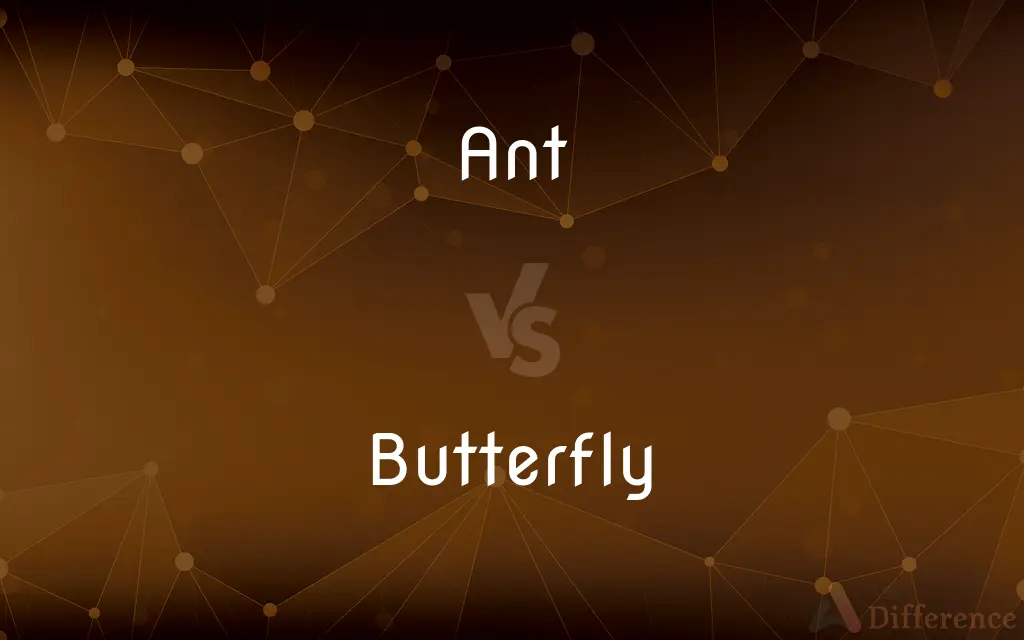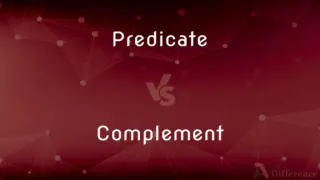Ant vs. Butterfly — What's the Difference?
By Maham Liaqat & Fiza Rafique — Updated on March 14, 2024
Ants are social insects known for their complex colonies and teamwork, while butterflies are admired for their colorful wings and role in pollination.

Difference Between Ant and Butterfly
Table of Contents
ADVERTISEMENT
Key Differences
Ants are small, hard-working insects that live in complex social colonies, often underground or in mounds. They are known for their structured social system, including roles such as workers, soldiers, and queens. Whereas, butterflies are flying insects with large, often brightly colored wings, and they go through a remarkable transformation from caterpillar to elder in their life cycle.
While ants are found almost everywhere and are crucial for tasks like aerating the soil and recycling nutrients, butterflies are important pollinators in many ecosystems. Their feeding on nectar from flowers not only aids in pollination but also contributes to the beauty of the natural environment. On the other hand, ants also have a role in the pollination process for some plants, though less directly than butterflies.
Ant colonies demonstrate an incredible level of organization, cooperation, and communication, often engaging in complex behaviors such as farming aphids or defending their colonies against predators. Butterflies, in contrast, lead more solitary lives after their metamorphosis and are more focused on reproduction and feeding, demonstrating behaviors like migrating long distances to avoid adverse weather or to breed.
The diet of ants can be quite varied, ranging from nectar and fungi to other insects, depending on the species. They are opportunistic feeders and play significant roles in the ecosystem as both predators and prey. Butterflies, however, primarily feed on nectar from flowers, using their long proboscis to drink. This diet makes them important pollinators but also vulnerable to habitat loss and pesticide use.
Despite their differences, both ants and butterflies have significant impacts on their ecosystems. Ants contribute to soil health and nutrient recycling, while butterflies, through pollination, support the growth of plants, which in turn provides food and habitat for a myriad of other creatures.
ADVERTISEMENT
Comparison Chart
Social Structure
Live in complex colonies with defined roles.
Mostly solitary after metamorphosis.
Role in Nature
Soil aeration, nutrient recycling, pollination.
Pollination, indicating ecosystem health.
Feeding
Varied diet including nectar, fungi, insects.
Primarily nectar from flowers.
Behavior
Demonstrates cooperation, farming aphids, defense.
Migration for breeding or avoiding cold.
Life Cycle
Simple metamorphosis (egg, larva, pupa, grown-up).
Complete metamorphosis with dramatic changes.
Compare with Definitions
Ant
Social Insects.
Ants form complex colonies with roles like worker, soldier, and queen, ensuring colony survival.
Butterfly
Pollinators.
Butterflies pollinate flowers while feeding on nectar, aiding plant reproduction.
Ant
Environmental Role.
Ants contribute to soil health by aerating it and recycling nutrients.
Butterfly
Indicator Species.
The presence of butterflies indicates a healthy ecosystem, as they are sensitive to environmental changes.
Ant
Diverse Diets.
Ants can eat nectar, fungi, or even other insects, adapting to available resources.
Butterfly
Nectar Feeders.
With their long proboscis, butterflies feed on nectar, contributing to their role as pollinators.
Ant
Complex Behaviors.
Some ant species farm aphids, protecting them in exchange for honeydew.
Butterfly
Migratory Patterns.
Monarch butterflies migrate thousands of miles to escape cold weather and breed.
Ant
Adaptability.
Ants are found in almost every terrestrial habitat, showcasing incredible adaptability.
Butterfly
Metamorphosis.
Butterflies undergo complete metamorphosis, transforming from caterpillars to fully growns.
Ant
Ants are eusocial insects of the family Formicidae and, along with the related wasps and bees, belong to the order Hymenoptera. Ants appear in the fossil record across the globe in considerable diversity during the latest Early Cretaceous and early Late Cretaceous, suggesting an earlier origin.
Butterfly
A nectar-feeding insect with two pairs of large, typically brightly coloured wings that are covered with microscopic scales. Butterflies are distinguished from moths by having clubbed or dilated antennae, holding their wings erect when at rest, and being active by day.
Ant
Any of numerous hymenopteran insects of the family Formicidae, characteristically having wings only in the males and fertile females and living in colonies that have a complex social organization.
Butterfly
A stroke in swimming in which both arms are raised out of the water and lifted forwards together.
Ant
Any of various insects in the family Formicidae in the order Hymenoptera, typically living in large colonies composed almost entirely of flightless females.
Butterfly
Split (a piece of meat or fish) almost in two and spread it out flat
Butterfly the shrimp using a small sharp knife
Ant
(Internet) A Web spider.
Butterfly
Any of numerous insects of the order Lepidoptera, having four broad, usually colorful wings, and generally distinguished from the moths by having a slender body and knobbed antennae and being active during the day.
Ant
(ornithology) To rub insects, especially ants, on one's body, perhaps to control parasites or clean feathers.
Butterfly
A person interested principally in frivolous pleasure
A social butterfly.
Ant
A hymenopterous insect of the Linnæan genus Formica, which is now made a family of several genera; an emmet; a pismire.
Butterfly
A swimming stroke in which a swimmer lying face down draws both arms upward out of the water, thrusts them forward, and draws them back under the water in an hourglass design while performing a dolphin kick.
Ant
Social insect living in organized colonies; characteristically the males and fertile queen have wings during breeding season; wingless sterile females are the workers
Butterfly
A race or a leg of a race in which this stroke is swum.
Butterfly
Butterflies A feeling of unease or mild nausea caused especially by fearful anticipation.
Butterfly
To cut and spread open and flat, as shrimp.
Butterfly
A flying insect of the order Lepidoptera, distinguished from moths by their diurnal activity and generally brighter colouring.
Butterfly
A use of surgical tape, cut into thin strips and placed across an open wound to hold it closed.
Butterfly tape; butterfly bandage; butterfly strips
Butterfly
(swimming) The butterfly stroke.
Butterfly
Any of several plane curves that look like a butterfly; see Butterfly curve (transcendental) and Butterfly curve (algebraic). Category:en:Curves
Butterfly
(in plural) A sensation of excited anxiety felt in the stomach.
I get terrible butterflies before an exam.
Butterfly
Someone seen as being unserious and (originally) dressed gaudily; someone flighty and unreliable.
Butterfly
(finance) A combination of four options of the same type at three strike prices giving limited profit and limited risk.
Butterfly
(alternate history) A random change in an aspect of the timeline seemingly unrelated to the primary point of divergence, resulting from the butterfly effect.
One potential butterfly could be JFK having another son the year after the POD instead of a daughter.
Butterfly
(sports) A type of stretch in which one sits on the ground with the legs folded into a shape like that of a butterfly's wings, slightly rocking them up and down, resembling the wings fluttering.
Butterfly
A person who changes partners frequently.
Butterfly
(transitive) To cut (food) almost entirely in half and spread the halves apart, in a shape suggesting the wings of a butterfly.
Butterflied shrimp
Butterfly the chicken before you grill it.
Butterfly
(transitive) To cut strips of surgical tape or plasters into thin strips, and place across (a gaping wound) to close it.
Butterfly
To cause events after the point of divergence to not happen as they did in real history, and people conceived after the point of divergence to not exist in recognizable form, due to the random variations introduced by the butterfly effect.
Pearl Harbor not happening would've butterflied Taylor Swift.
Butterfly
A general name for the numerous species of diurnal Lepidoptera.
Butterfly
Diurnal insect typically having a slender body with knobbed antennae and broad colorful wings
Butterfly
A swimming stroke in which the arms are thrown forward together out of the water while the feet kick up and down
Butterfly
Flutter like a butterfly
Butterfly
Cut and spread open, as in preparation for cooking;
Butterflied shrimp
Butterfly
Talk or behave amorously, without serious intentions;
The guys always try to chat up the new secretaries
My husband never flirts with other women
Common Curiosities
Why are ants important to the ecosystem?
Ants play key roles in soil aeration, nutrient recycling, and sometimes pollination, contributing to ecological balance.
How do butterflies contribute to the environment?
Butterflies are vital pollinators, aiding in the reproduction of many flowering plants, which benefits the overall ecosystem.
What is the significance of butterfly metamorphosis?
Butterfly metamorphosis allows for a complete transformation, enabling the survival and dispersal of the species through distinct life stages.
What distinguishes ants from butterflies?
Ants are social insects living in colonies with structured roles, while butterflies are known for their solitary nature post-metamorphosis and colorful wings.
Can ants pollinate plants like butterflies?
While ants are not as well-known for pollination as butterflies, certain species do help pollinate plants.
Do all ants have the same diet?
No, ant diets vary widely among species, ranging from nectar and fungi to other insects or even small animals.
Are there any ants that are harmful to humans?
Some ant species, like fire ants, can be harmful to humans, causing painful stings or damaging crops.
What role do butterflies play in indicating environmental health?
Butterflies are indicator species, meaning their presence or absence can signal changes in environmental health, such as habitat loss or pollution.
How do ants benefit humans?
Ants benefit humans by aerating soil, decomposing organic matter, and even controlling pest populations.
Can the behavior of ants affect other animals?
Yes, ants can affect other animals by competing for resources, acting as predators or prey, and even forming mutualistic relationships.
How can people help conserve butterflies?
People can help conserve butterflies by planting native flowers, reducing pesticide use, and protecting natural habitats.
How do ants communicate within their colonies?
Ants communicate through chemicals called pheromones, which can signal danger, lead to food sources, or help with colony organization.
Why do butterflies migrate?
Butterflies migrate to avoid adverse weather conditions, like cold, and to find suitable breeding grounds or food sources.
What challenges do butterflies face?
Butterflies face challenges such as habitat loss, climate change, and pesticide use, which threaten their survival and migration patterns.
How does butterfly pollination differ from bee pollination?
Butterfly pollination often involves less efficient but wider-ranging pollination due to their feeding habits and flight patterns, compared to the more focused pollination by bees.
Share Your Discovery

Previous Comparison
Soothsayer vs. Prophet
Next Comparison
Predicate vs. ComplementAuthor Spotlight
Written by
Maham LiaqatCo-written by
Fiza RafiqueFiza Rafique is a skilled content writer at AskDifference.com, where she meticulously refines and enhances written pieces. Drawing from her vast editorial expertise, Fiza ensures clarity, accuracy, and precision in every article. Passionate about language, she continually seeks to elevate the quality of content for readers worldwide.














































